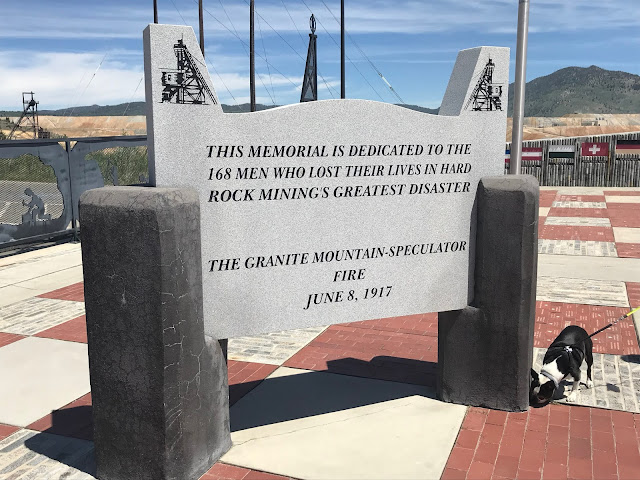Butte has only some 35,000 residents, so we had a preconceived notion that there wasn’t much to see and do here, so we slept in this morning and didn’t head into town until about 11. Turns out that Butte is and always will be a mining town. Butte was established in 1864 as a mining town and soon grew in the late 19th century and early 20th century on the strength of copper, silver and gold. Millions of ounces of valuable metal have been extracted from the surrounding hills, leading Butte to become the largest city between San Francisco and Chicago in the 1880’s. “Copper Kings” built mansions on Summit street so that they could keep an eye on their mines. The huge mines and the wealth that was accumulated led Summit Hill to be called “The Richest Hill on Earth”
Anacondas most famous operation in Butte was The Con, so named because it was a consolidation of several mines. It was located at an elevation of more than a mile, and has shafts that burrow more than a mile deep!
From the Con Site, the view of Butte is amazing. Butte lies in a bowl valley that straddles the Continental Divide. Leaving the valley east, north, or south, a traveler must cross the Divide.
Mining is inherently dangerous, and one of the worst disasters in mining history took place in the Speculator Mine on June 8, 1917, when a carbide lamp ignited an oiled rope, which in turn, ignited flammable gases and cost 168 men their lives. A memorial overlooks the site of the mine.
The Anaconda, along with other mines, eventually switched from headframe mining to open pit mining, and opened up the Berkeley Pit northeast of town. This pit eventually ate the nearby towns of Meaderville, McQueen, and the amusement park built by the Copper Kings
There are numerous mine sites and headframes in the area surrounding Butte, but this site of The Lex caught out attention. It’s now used as a flagpole and cell tower.
Back in town, we drove along Excelsior St, Iron St, Silver St, Platinum St….you get the idea. There are some wonderful examples of turn of the century homes.
On the lower slopes of town, the homes aren’t quite as majestic, but are still so very interesting.
From the top of Iron Street, we got a different view of Butte.
East of town, on the Continental Divide, is a statue of The Virgin Mary, called Our Lady of the Rockies.
At 90 feet tall, and 8,510 feet above sea level, the statue is on private land accessible only by bus and is lit at night. We didn’t know access was limited, so we found a likely dirt road. Unfortunately, Google had sent us to a road with a sign saying “Google is wrong, go away”. We did.
Seemingly unnoticed near Interstate 90, the Butte Batholith sits in an industrial park.
A batholith is a mass of magma that cools beneath the earths surface and is eventually exposed by erosion. We couldn’t understand why something so awesome didn’t have a sign or viewing area. We parked in the backlot of CED electrical and took a look.
In the eastern part of Butte, a warehouse has been converted to a restaurant called Casagranda’s Steakhouse.
Owned and operated by the Casagranda family, it’s Butte’s premiere steakhouse. We stopped by at opening time, 5 pm, to find that no tables were available. Sitting at the bar turned out famously since the young lady taking our orders was a civil engineering student. She was extremely efficient and a great conversationalist.
Donna and I both ordered 8 oz Petite Filets, she with mushrooms and mine with sautéed onions. A salad, soup of the day (chili), bread, and potato (twice baked and “once” baked.) Ice cream completed the meal, and the cost? $37 each! The steaks were absolutely perfect. We would return in a heartbeat!
As usual, we discover more things to see and do than we have time to do. The World Mining Mueseum is located in Butte, as well as a coffee shop called “Shebrews Coffee.” Gotta come back!
This was to have been posted yesterday, but the internet connection failed. I hope this works tonight!






















No comments:
Post a Comment